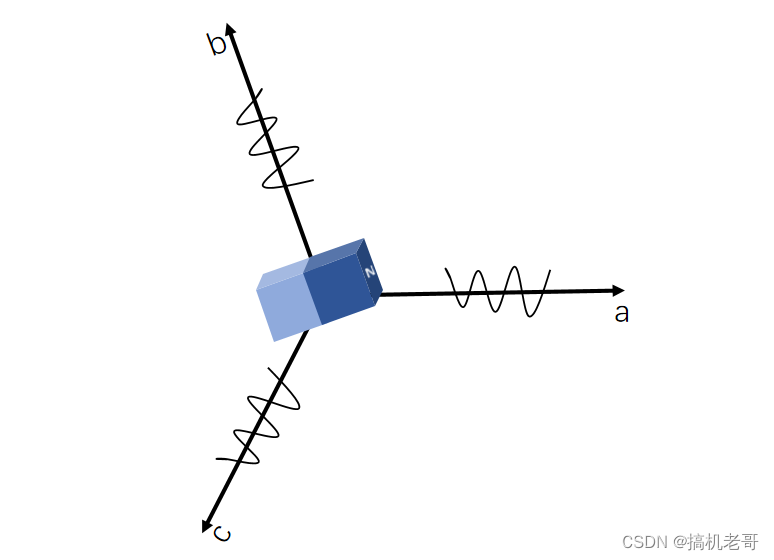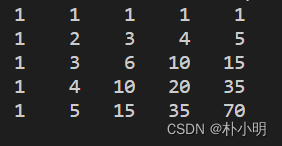当前位置:网站首页>Minimum cut edge set of undirected graph
Minimum cut edge set of undirected graph
2022-07-06 20:29:00 【Jose H】
reference
- The minimum cut of an undirected graph
- graph theory : Detailed explanation of maximum flow and minimum cut
codes
- The minimum cut of an undirected graph Code corresponding to the method of solving the global minimum cut in
from random import choice
from copy import deepcopy
import networkx as nx
import matplotlib.pyplot as plt
import sys
sys.setrecursionlimit(5000)
def init_graph():
G = nx.Graph()
edges = []
# with open('example.txt', 'r') as graphInput:
with open('case3.txt', 'r') as graphInput:
# with open('case1.txt', 'r') as graphInput:
for line in graphInput:
ints = [int(x) for x in line.split()]
edges.append(ints)
G.add_edges_from(edges,weight=1)
# nx.draw(G,with_labels=True)
# plt.show()
return G
def merge(G,s,t):
neighbours = dict(G[t]) # Cut this point out
G.remove_node(t)
for i in neighbours:
if(s==i):
pass
elif(G.has_edge(s,i)): # If t So are my neighbors s Neighbors of , Just move the size of this stream to s, Give Way s Responsible for transmission
G[s][i]['weight'] += neighbours[i]['weight']
else: # otherwise
G.add_edge(s,i,weight=neighbours[i]['weight'])
return G
def min_cut(G,s,clo):
"""[summary] Args: G ([type]): [list of edges] s ([int]): [start node index] clo ([type]): [description] Returns: [type]: [description] """
if(len(G)>2):
clo = max(G[s].items(),key=lambda x:x[1]['weight'])[0] # Select a neighbor node according to the weight . Parallel words , Still return to the first
# import ipdb
# ipdb.set_trace()
merge(G,s,clo)
return min_cut(G,s,clo)
else:
return list(dict(G[s]).keys())[0],clo,list(dict(G[s]).values())[0]['weight'] # When there are only two sides left , It returns the starting node and weight of the current cut (1st,3rd Elements ) as well as Cut out point col
def stoer_wagner(G,global_cut,u_v,s):
"""[summary] Args: G ([type]): [list of edges] global_cut ([int]): [max cut number so far] u_v ([list]): [ The minimum cut occurs s and t Node pair ] s ([int]): [start node index] Returns: [type]: [final global_cut and u_v] """
#print("number of points:",len(G))
if(len(G)>2):
clo = 0
u,v,w = min_cut(deepcopy(G),s,clo)
merge(G,u,v)
if(w<global_cut):
global_cut = w
u_v = (u,v)
return stoer_wagner(G,global_cut,u_v,s)
else:
last_cut = list(dict(G[s]).values())[0]['weight']
if(last_cut<global_cut):
global_cut = last_cut
u_v = (s,list(G[s])[0])
return global_cut,u_v
if __name__ == '__main__':
G = init_graph()
s = choice(list(G.nodes())) # randomly choose a vertex
global_cut = 99999
u_v = ('0', '0')
global_cut, u_v = stoer_wagner(G, global_cut, u_v, s)
print("global min cut",global_cut,"\nnodes:", u_v)
This can find the minimum cut edge set s and t What is the node pair and what is the corresponding minimum cutting edge .
And then you can use graph theory : Detailed explanation of maximum flow and minimum cut The last method inside is to find the corresponding edge of the minimum cut
import copy
from collections import deque,defaultdict
from linecache import getline
""" order = dict() def buildNode2Order(): global order pass def Node2Order(): pass """
def hasPath(Gf, s, t, path):
# BFS algorithm
# V = len(Gf)
# visited = list(range(V))
# visited = defaultdict(getFalse)
visited = dict()
# for i in range(V):
# visited[i] = False
for node in Gf.keys():
visited[node]=False
visited[s] = True
queue = deque([s])
while queue:
temp = queue.popleft()
if temp == t:
return True
# print("temp =", temp)
for i in Gf.keys():
if not visited[i] and (Gf[temp].get(i,0) > 0):
queue.append(i)
visited[i] = True
path[i] = temp # record precursor
return visited[t]
def max_flow(capDict, s, t):
maxFlow = 0
Gf = copy.deepcopy(capDict)
print(f"Gf is {
Gf}")
V = len(Gf)
# path = list(range(V))
path = dict()
while hasPath(Gf, s, t, path):
print(f"path is {
path}")
min_flow = float('inf')
# find cf(p)
v = t
while v != s:
u = path[v]
min_flow = min(min_flow, Gf[u][v])
v = path[v]
print(min_flow)
# add flow in every edge of the augument path
v = t
while v != s:
u = path[v]
Gf[u][v] -= min_flow
Gf[v][u] += min_flow
v = path[v]
maxFlow += min_flow
nodes = getNodesSet(Gf,s)
return maxFlow, nodes
# return maxFlow
def getNei(cur,resG):
# V = len(resG)
neighs = []
# for idx in range(V):
for node in resG.keys():
if resG[cur].get(node,0)>0:
neighs.append(node)
return neighs
def dfs(cur,visited,resG):
visited[cur]=True
for nei in getNei(cur,resG):
if not visited[nei]:
dfs(nei,visited,resG)
def getNodesSet(Gf,s):
resG =copy.deepcopy(Gf)
V = len(Gf)
visited=dict()
for node in resG.keys():
visited[node]= False
for cur in getNei(s,resG):
dfs(cur,visited,resG)
nodes=[]
# for node in range(V):
for node in resG.keys():
if visited[node]:
nodes.append(node)
return nodes
def testDictInput():
# read in capDict
from collections import defaultdict
capDict = defaultdict(dict)
with open("case1.txt",'r') as f: # nodes with continuous indice
lines= f.readlines()
for line in lines:
nodes = list(map(int,line.split()))
fromNode,toNode = nodes[0],nodes[1]
capDict[fromNode][toNode] = 1
capDict[toNode][fromNode] = 1
print(f"capDict is {
capDict}")
flow,nodes = max_flow(capDict, 0, 4)
print(f"flow is {
flow}, with nodes of {
nodes}")
# flow = max_flow(capDict, 0, 4)
# print(f"flow is {flow}")
def initFromNX(G,s,t):
from collections import defaultdict
capDict = defaultdict(dict)
return capDict
if __name__ == "__main__":
testDictInput()
边栏推荐
- Core principles of video games
- 01 基础入门-概念名词
- Quel genre de programmation les enfants apprennent - ils?
- rt-thread i2c 使用教程
- Maximum likelihood estimation and cross entropy loss
- Le lancement du jupyter ne répond pas après l'installation d'Anaconda
- Learn to punch in Web
- [network planning] Chapter 3 data link layer (3) channel division medium access control
- 8086指令码汇总表(表格)
- Why do novices often fail to answer questions in the programming community, and even get ridiculed?
猜你喜欢

夏志刚介绍

2022 refrigeration and air conditioning equipment installation and repair examination contents and new version of refrigeration and air conditioning equipment installation and repair examination quest

Special topic of rotor position estimation of permanent magnet synchronous motor -- fundamental wave model and rotor position angle

Number of schemes from the upper left corner to the lower right corner of the chessboard (2)

使用.Net驱动Jetson Nano的OLED显示屏

Anaconda安裝後Jupyter launch 沒反應&網頁打開運行沒執行

Error analysis ~csdn rebound shell error

【Yann LeCun点赞B站UP主使用Minecraft制作的红石神经网络】

2022 Guangdong Provincial Safety Officer C certificate third batch (full-time safety production management personnel) simulation examination and Guangdong Provincial Safety Officer C certificate third

JMeter server resource indicator monitoring (CPU, memory, etc.)
随机推荐
Error analysis ~csdn rebound shell error
OLED屏幕的使用
设计你的安全架构OKR
22-07-05 七牛云存储图片、用户头像上传
Rhcsa Road
Technology sharing | packet capturing analysis TCP protocol
Function optimization and arrow function of ES6
Review questions of anatomy and physiology · VIII blood system
22-07-05 upload of qiniu cloud storage pictures and user avatars
Linear distance between two points of cesium
Groovy基础语法整理
枚举根据参数获取值
Boder radius has four values, and boder radius exceeds four values
Recyclerview GridLayout bisects the middle blank area
持续测试(CT)实战经验分享
5. 无线体内纳米网:十大“可行吗?”问题
Is it difficult for small and micro enterprises to make accounts? Smart accounting gadget quick to use
Case ① | host security construction: best practice of 3 levels and 11 capabilities
数字三角形模型 AcWing 1018. 最低通行费
Force deduction brush question - 98 Validate binary search tree